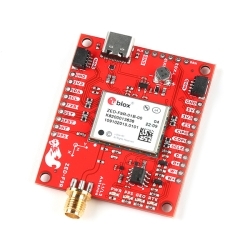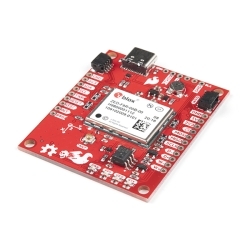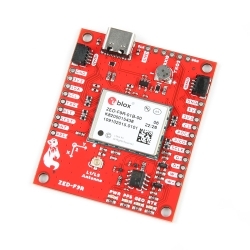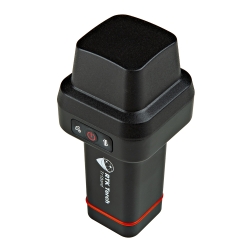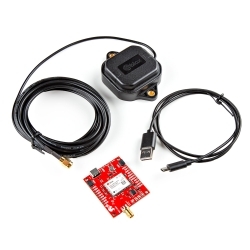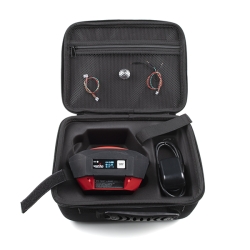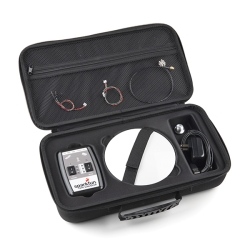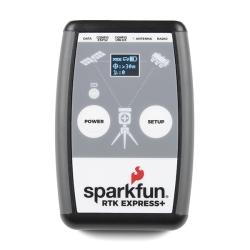SparkFun GNSS-RTK L1/L5 Breakout - NEO-F9P (Qwiic)
The SparkFun GNSS-RTK L1/L5 Breakout - NEO-F9P (Qwiic) is a high precision GNSS board with equally impressive configuration options.
Product Overview
The SparkFun GNSS-RTK L1/L5 Breakout - NEO-F9P (Qwiic) is a high-precision GNSS board with equally impressive configuration options. The NEO-F9P utilizes the L1/L5 bands instead of the the more commonly seen L1/L2 option. Utilizing the L5 band, the NEO-F9P delivers improved performance under challenging urban environments because the L5 signals fall within the protected ARNS (aeronautical radio navigation service) frequency band. This band is less subject to RF interference.
The NEO-F9P module is a powerful 184-channel u-blox F9 engine GNSS receiver, meaning it can receive signals from the GPS, GLONASS, Galileo, and BeiDou constellations with 10mm, three-dimensional accuracy! That's right; such accuracy can be achieved with an RTK navigation solution when used with a correction source. With this board, you will be able to know where your (or any object's) X, Y, and Z location is within roughly the width of your fingernail! The module supports the concurrent reception of four GNSS systems. This module features a survey-in mode, allowing the module to become a base station and produce RTCM 3.x correction data.
We've included a rechargeable backup battery to keep the latest module configuration and satellite data available for up to two weeks. This battery helps 'warm-start' the module, decreasing the time-to-first-fix dramatically from a cold start of ~27s down to a hot start of ~3s. The battery will maintain RTC and GNSS orbit data without being connected to power for plenty of time. We have included an SMA connector for a secure connection.
The NEO-F9P even has five communications ports, which are all active simultaneously: USB-C (which enumerates as a COM port), UART1 (with 3.3V TTL), UART2 for RTCM reception (with 3.3V TTL), I2C, and SPI. Utilizing our handy Qwiic system, no soldering is required to connect it to the rest of your system. However, we still have broken out 0.1"-spaced pins if you prefer a breadboard.
u-blox-based GPS products are configurable using the popular but dense Windows program u-center. Many different functions can be configured on the NEO-F9P: baud rates, update rates, geofencing, spoofing detection, external interrupts, SBAS/D-GNSS, increasing the high precision RTK solution to 20Hz, etc. All of this can be done within the SparkFun Arduino Library!
Our extensive Arduino Library for u-blox modules makes reading and controlling the GNSS-RTK over our Qwiic Connect System easy. Leave NMEA behind! Start using a much lighter-weight binary interface and give your microcontroller a break. The SparkFun Arduino library shows how to read latitude, longitude, even heading, and speed over I2C without constant serial polling.
-
-
-
-
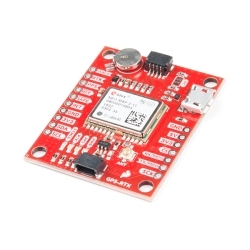 SparkFun GPS-RTK Board - NEO-M8P-2 (Qwiic)
Special Price Current price: $179.95 Regular Price Original price: $269.95In stock
SparkFun GPS-RTK Board - NEO-M8P-2 (Qwiic)
Special Price Current price: $179.95 Regular Price Original price: $269.95In stock -
-
-
-
-
-
-
Features & Specs
Board Features:
- 1x USB Type C Connector
- 2x Qwiic Connectors
- Default I2C Address: 0x42
- Integrated SMA connector
- Concurrent reception of GPS, GLONASS, Galileo and BeiDou
- 184-Channel GNSS Receiver
- Receives L1/L5 Bands
- Voltage: 5V or 3.3V but all logic is 3.3V
- Current: 95mA - 135mA (varies with constellations and tracking state)
- Time to First Fix: 27s (cold), 3s (hot)
Max Navigation Rate:
- RTK (basic location over UBX binary protocol) - 25Hz
- PVT - 25Hz
- RAW - 25Hz
Horizontal Position Accuracy:
- 1.5m without RTK
- 0.01m with RTK
Vertical Position Accuracy:
- 2.0m without RTK
- 0.01m with RTK
- Time Pulse Accuracy: 30ns
Operational Limits
- Max G: ≤4G
- Max Altitude: 80km (49.7 miles)
- Max Velocity: 500m/s (1118 mph)
Software Configurable
- Geofencing
- Odometer
- Spoofing Detection External Interrupt
- Pin Control Low Power Mode
- Many others!
- Supports NMEA, UBX, RTCM, SPARTN, CLAS protocols over UART or I2C interfaces
- Power LED
Jumpers
- USB Shield
- Power LED
- 3v3 (for UART2 Port)
- I2C Pull-Up Resistors
- SPI
- Pulse Per Second (PPS)
- RTK Status LED
Board Dimensions
- 1.70" x 1.70" (43.2mm x 43.2mm)
Documentation
SparkFun Resources
- Schematic
- Eagle Files
- Board Dimensions
- Hookup Guide
- Qwiic Info Page
- Building a GPS System
- RTK Solutions
- Arduino Library
- GitHub Hardware Repo
u-blox NEO-F9P Resources
Customer Reviews



 Hookup Guide
Hookup Guide Schematic
Schematic Datasheet
Datasheet


